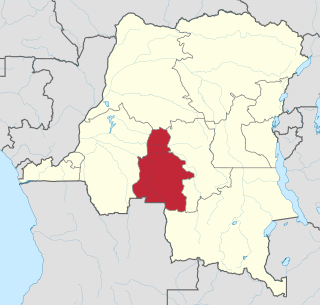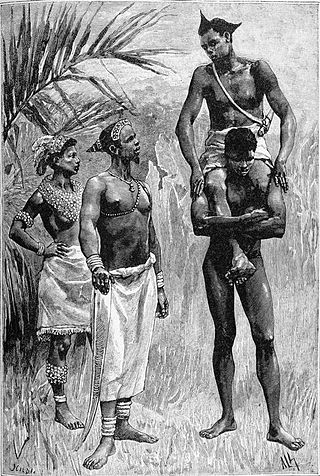This article needs additional citations for verification .(January 2008) |
Ilunga Mbidi was a soldier and cultural hero of the Luba and Lunda people.
This article needs additional citations for verification .(January 2008) |
Ilunga Mbidi was a soldier and cultural hero of the Luba and Lunda people.
The details of his origins are not known. It is likely that he came from another Bantu kingdom to the East of the Lualaba river.
Kongolo was a tyrant ruling over indigenous people of the Upemba Depression. Wanting to create a kingdom, he consulted the prophet Mujibu. Mujibu prophesied that he could never rule as he was a commoner; but soon the Bulopwe “sacral royal blood” would arrive. If he welcomed him properly, blessings and prosperity would come with the Bulopwe and Kongolo would establish a kingdom, but if he went against him; his God would take away his ruler ship and he would be put to death.
For unknown reasons Ilunga Mbili left his Kingdom which general belief place it to the east of Lake Tanganyika. He came out of a lake where he meets Kongolo’s sisters Mabela and Bulala. Contrary to the natives, he was tall and dark complexioned and had thin features accentuated by his sharp nose. He wore a red feather on his head and by his princely garments, Mabela and Bulala recognized him as nobility so they decided to escort him and his suites to Kongolo.
Kongolo welcomed Ilunga Mbili to his court and eventually put him at the head of his army. Ilunga Mbili was a military strategist, and advised Kongolo on political matters as well; he led wars in all directions and expanded Kongolo’s control of the land to create the Luba Kingdom in 1585. Kongolo gave him his two sisters in marriage and he begat two sons, Kalala Ilunga from Mabela and Tshibinda Ilunga from Bulala.
Ilunga Mbili was a warrior, a hunter and prophet. He was feared and exalted for his mystical abilities; he introduced his God, his religion and culture to the Kingdom. His fame overshadowed that of Kongolo which created many conflicts between the two. Against the advice of the prophet Mujibu, Kongolo plots to have Ilunga Mbili assassinated. Mabela and Bulanda inform him of their brother’s plot. Ilunga Mbili gives each of his wives a red feather and his princely attributes and instructs them to give it to his children when they become men, and they are to find him and show these attributes if they want him to recognize them as his sons.
Ilunga Mbili blessed his children and put them under the protection of the Angel and went back to his Kingdom with his suites. He never came back, it is said that he left as he came, on water. His children grew up under the guidance of the prophet Mujibu, and eventually fulfilled Mujibu’s prophecy by killing their uncle Kongolo.
Out of him came two empires, that of the Luba Empire under his son Kalala Ilunga and that of the Lunda Empire under his second son Tshibinda Ilunga. Today he is claimed as an ancestor and civilizing hero by different Kingdoms and Chiefdoms of both Kasai provinces and Katanga province of the Democratic Republic of Congo, eastern Angola and Zambia including such people as the Kazembe, Chokwe, and Bemba people.
His direct descendants through Tshibinda Ilunga are the Bakwa Dishi of Miabi ruled by Mbayi Futa Tshitumbu also known as Andre-Philippe Futa. The Bakwa Dishi left the Lunda Empire in mid 17th century due to civil wars from the Lunda people and settled in the current Kasai-oriental Province of the Democratic Republic of Congo. His direct descendant through Kalala Ilunga are those of the Luba-Kabongo whose present ruler is Kumwimba Kabongo Kansh’imbu and Luba-Kasongo whose last ruler was Kisula Ngoy in 1964; Kalala Ilunga’s lineage split in two in 1889 due to succession disputes.

Zambia, officially the Republic of Zambia, is a landlocked country at the crossroads of Central, Southern and East Africa, and is typically referred to as being in South-Central Africa. Its neighbours are the Democratic Republic of the Congo to the north, Tanzania to the northeast, Malawi to the east, Mozambique to the southeast, Zimbabwe and Botswana to the south, Namibia to the southwest, and Angola to the west. The capital city is Lusaka, located in the south-central part. The population of around 20.1 million (2023) is concentrated mainly around Lusaka in the south and the Copperbelt Province to the north, the core economic hubs of the country.
The history of Zambia experienced many stages from colonization to independence from Britain on October 24, 1964. Northern Rhodesia became a British sphere of influence in the present-day region of Zambia in 1888, and was officially proclaimed a British protectorate in 1924. After many years of suggested mergers, Southern Rhodesia, Northern Rhodesia, and Nyasaland were merged into the British Federation of Rhodesia and Nyasaland.

Kasaï-Occidental was one of the eleven provinces of the Democratic Republic of the Congo between 1966 and 2015, when it was split into the Kasaï-Central and the Kasaï provinces.
The pre-colonial history of the modern-day Democratic Republic of the Congo encompasses the history of the Congo Basin region up to the establishment of European colonial rule in the era of New Imperialism and particularly the creation of the Congo Free State and its expansion into the interior after 1885. As the modern territorial boundaries of the Democratic Republic of the Congo did not exist in this period, it is inseparable from the wider pre-colonial histories of Central Africa, the Great Lakes and Rift Valley as well as the Atlantic World and Swahili coast.

The Lukuga River is a tributary of the Lualaba River in the Democratic Republic of the Congo (DRC) that drains Lake Tanganyika. It is unusual in that its flow varies not just seasonally but also due to longer term climate fluctuations.

The Luba people or Baluba are an ethno-linguistic group indigenous to the south-central region of the Democratic Republic of the Congo. The majority of them live in this country, residing mainly in Katanga, Kasai and Maniema. The Baluba Tribe consist of many sub-groups or clans who speak various dialects of Luba and other languages, such as Swahili.

Kazembe is a traditional kingdom in modern-day Zambia, Southeastern Congo. For more than 250 years, Kazembe has been an influential kingdom of the Kiluba-Chibemba, speaking the language of the Eastern Luba-Lunda people of south-central Africa. Its position on trade routes in a well-watered, relatively fertile and well-populated area of forestry, fishery and agricultural resources drew expeditions by traders and explorers who called it variously Kasembe, Cazembe and Casembe.

André-Philippe Futa was a politician in the Democratic Republic of the Congo. He was originally from Miabi in Tshilenge District.

The Nation of Lunda was a confederation of states in what is now the Democratic Republic of Congo, north-eastern Angola, and north-western Zambia, its central state was in Katanga.

The Lunda are a Bantu ethnic group that originated in what is now the Democratic Republic of the Congo along the Kalanyi River and formed the Kingdom of Lunda in the 17th century under their ruler, Mwata Yamvo or Mwaant Yav, with their capital at Musumba. From there they spread widely through Katanga and into Eastern Angola, north-western Zambia and the Luapula valley of Zambia.
The Bakwa Dishi is a people belonging to the Luba ethnic group living today in the Kasai-Oriental Province in the Democratic Republic of Congo. Miabi, the Dishi Capital, is located 16 miles (26 km) West of Mbuji-Mayi. The territory of the Bakwa Dishi lies on approximately 1,900 square miles (4,900 km2), which is known as the Miabi territory.
Tshibinda Ilunga was a Luba Prince and Emperor of the Lunda and their civilizing hero.
Kalala Ilunga was a Prince, King and one of the emperors of Luba Empire, the latter of which spread over the province of Katanga into Zambia and Zimbabwe. A mythic cultural hero who had invented much of Luba culture, Kalala is the first sacred King of the Kingdom of Luba and its most revered son. As the Egyptian Pharaohs and rulers in much of Ancient Egypt and antique world, Luba kings were revered as deities upon death, comparable to Christian "saints’ lives".
Ilunga Tshibinda was a Mwata Gaand of Luba descent. He was the second son of Ilunga Mbidi and younger brother Kalala Ilunga.
Kongolo was a leader of Luba people in the region of Katanga, and the first king of the Luba Empire. He built his capital in Mwibele, near Lake Boya. Kongolo Mwamba was trying to extend his kingdom in conquering the Songye neighbouring chiefdoms.

The Kingdom of Luba or Luba Empire (1585–1889) was a pre-colonial Central African state that arose in the marshy grasslands of the Upemba Depression in what is now southern Democratic Republic of Congo.
Ilunga Sungu was a ruler (Mulopwe) of the Kingdom of Luba in what is now the Katanga Province of the Democratic Republic of the Congo, said to have reigned from about 1780 to his death.
The Hemba people are a Bantu ethnic group in the Democratic Republic of the Congo (DRC).
Queen Diambi Kabatusuila Tshiyoyo Muata is the traditional queen of the Bakwa Luntu tribe of Central Kasaï in the historic Kingdom of Luba.